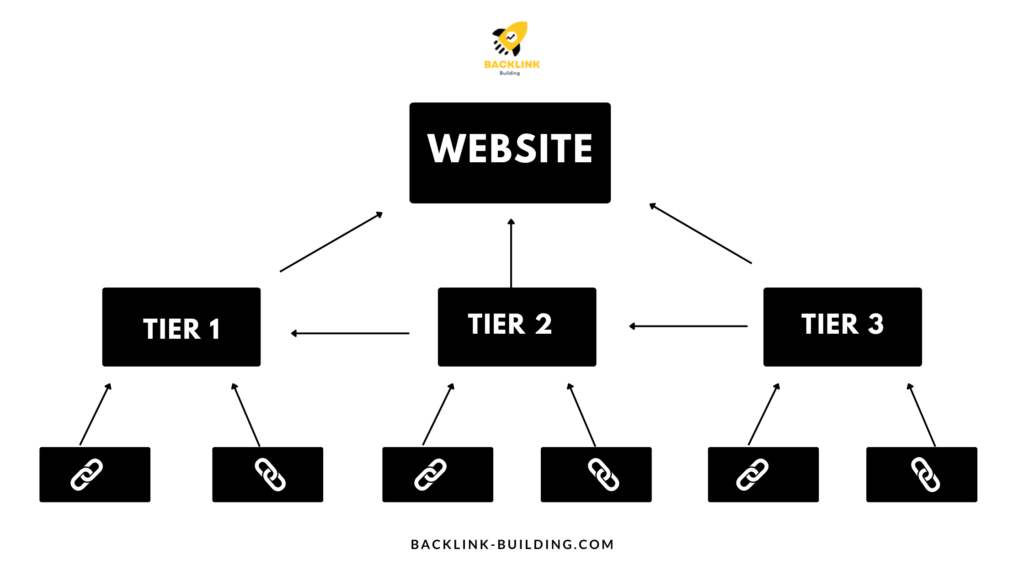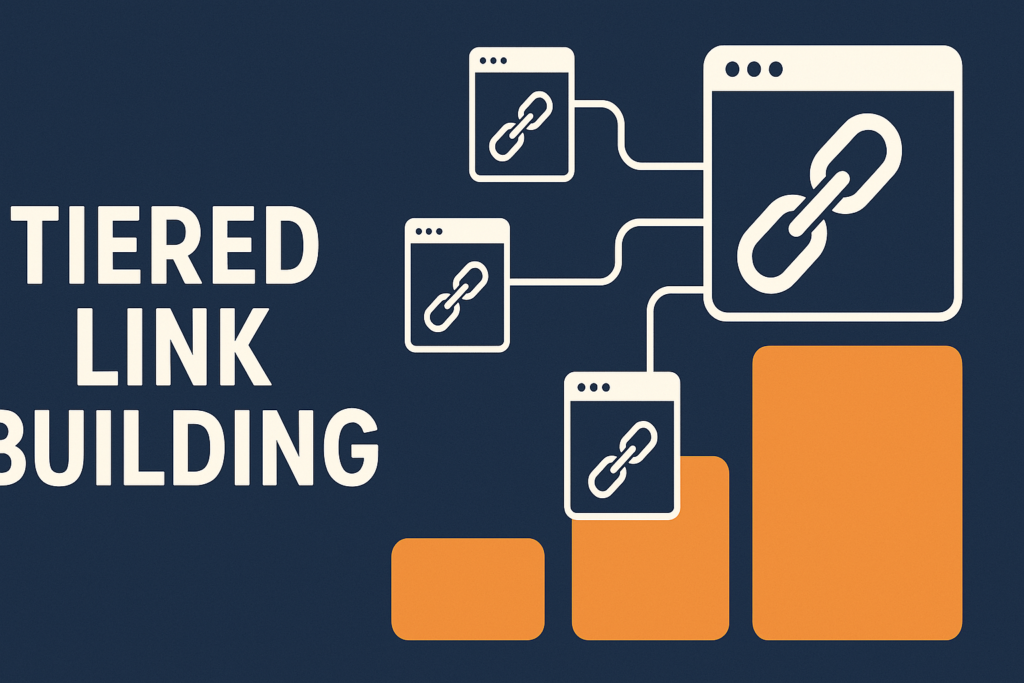
Tiered link building is a backlinking strategy that never fails to deliver good results. It’s a three-tier approach that can help you get high-quality links from different sources.
This article will discuss tiered link building, its benefits, and the risks involved in using this approach. We’ll also answer some of the most frequently asked questions about tiered link building. Finally, we’ll give you our final thoughts on this strategy.
So, let’s get started by defining link building.
What Is Link Building?
Link building is a strategy websites use to increase their visibility and improve their search rankings on search engines like Google.
It typically involves acquiring high-quality backlinks from other websites and blogs, which can help improve your website’s authority and credibility in search engines’ eyes.
Now, Let’s understand tiered link building.
What Is Tiered Link Building?

It refers to a three-tiered approach that involves creating backlinks from multiple sources, with each tier of links being more potent than before.
It is a time-tested approach that has been proven effective in boosting search rankings and increasing website traffic. This approach has several benefits; we will discuss them later in this blog.
Now that you know what link building and tiered link building are let’s talk about different tiered link-building strategies.
Tiered Link Building Strategy: A Winning Backlink Strategy.
Tier 1
The first tier of tiered links refers to the backlinks you acquire directly from high-quality, authoritative websites in your niche. These are typically the most powerful backlinks that can help improve your website’s search rankings and drive more traffic.
When Building tier 1 backlinks, creating quality content that resonates with your target audience is essential. You should also note that the backlinks you are generating from tier one should be do-follow backlinks so that They can transfer the authority to a website.
Some of the examples of Tier 1 are as follows:
- .EDU Backlinks from universities or colleges
- Contextual backlinks from high authority websites like Wikipedia, CNN, Forbes, etc.
- High-Quality Guest Posts on blogs with good traffic and domain authority.
- Industry publications and relevant websites that are likely to share your content.
Tier 2
The second tier of tiered links involves creating backlinks from high-quality websites and blogs, but not as authoritative or prominent as the ones in tier 1. The primary purpose of tier 2 backlinks is to provide value to the tier 1 backlinks and help boost their authority.
When building tier 2 backlinks, it is essential to focus on quality and quantity. It would be best if you also aimed to get these backlinks from different domains and IP addresses, which can help diversify your link profile.
Some Examples of tier 2 backlinks include:
- Local Directories
- Social media profiles and shares
- Blogs and forums with high domain authority but not as popular as those in tier 1.
- Guest posts on websites and blogs that are not as authoritative or prominent in your niche.
Tier 3
The third tier of tiered links involves creating backlinks from lower-quality websites and blogs. These links are primarily used for diversification purposes, as they can help balance out the link profile by providing a more natural appearance to search engines.
Some examples of tier 3 backlinks are:
- Web directories
- Low-quality blogs and forums with little to no domain authority
- Comment sections on blogs and forums
- Directories that have less genuine traffic or engagement.
As you can see, many-tiered link-building strategies can be used depending on your specific needs and goals. And while each tiered approach comes with its own set of risks, it is essential to remember that these strategies have been proven effective repeatedly at boosting search rankings and driving more traffic.
Now that you know the types of tiered link building let’s understand the benefits and risks involved.
Benefits Of Tiered Link Building
- Increases Ranking
It has been shown to improve search rankings significantly, mainly when combined with quality content and other SEO best practices. They also help improve your website’s authority, a crucial factor that search engines consider when ranking websites.
- Increases Traffic
It helps improve your search rankings and drives more traffic to your website. This increased traffic can significantly increase your business’s visibility and brand awareness, leading to more conversions and overall growth.
- Better ROI
It can have a higher return on investment than other link-building strategies due to its long-term benefits. When done correctly, this strategy can help improve your website’s search rankings for years to come – thereby helping you achieve greater returns from your efforts in terms of traffic and conversions.
- Diversified Link Profile
A well-diversified link profile is crucial for any successful SEO campaign. Tiered backlinking helps boost the authority of other links by providing more variety and depth to your link profile, thereby making it more natural and credible in the eyes of search engines.
- Cost-Effective
It is a cost-effective strategy that can help you achieve better returns with only a tiny investment. While some initial work involves creating content, curating links, and analyzing results, this approach typically requires less time and money than paid advertising or other outreach strategies.
However, tiered link building has some risks that should be considered before implementing this strategy into your SEO campaign. These include:
Risks Involved In Tiered Link Building
- Spammy Websites
They often uses lower-quality websites such as blog comments and directories with little domain authority. While these sites can help improve your website’s link profile and boost your search rankings, they also risk being viewed as spammy or low-quality, negatively impacting your site’s SEO performance.
- Negative SEO
It can also leave you vulnerable to negative SEO tactics that involve hacking or manipulating the links on tier 2 and tier 3 websites to direct more traffic to competitor websites instead of yours. This is why it is essential to carefully monitor all backlinks pointing at your website and take action if necessary.
- Duplicate Content
They rely heavily on content curation from different sources, which may result in duplicate content across multiple tiers. Search engines are known to penalize websites with duplicate content, so it is crucial to do your due diligence when creating tiered links and ensure that the content used in them is unique.
As you can see, many benefits and risks are involved in tiered link-building strategies for your website’s SEO campaign.
FAQs
Q. What Is Tiered Link Building, And How Does It Work?
It is a strategy that involves using multiple tiers of backlinks to build a more credible and natural-looking link profile for your website. This is typically achieved by creating high-quality content, curating links from different sources, and analyzing results over time to identify areas of improvement.
Q. How Are The Different Tiers Created?
The first tier usually consists of high-quality content published on authoritative websites or blogs with strong domain authority. Tiered links can be created within this tier using various techniques, such as guest posting, social media sharing, and blog commenting. These lower tiers may also contain links pointing back to your website and other relevant information about your business or industry.
Final Thoughts
Now that you understand the basics of tiered link building, it is essential to consider how this strategy can help improve your SEO performance over time.
Whether you are just starting with SEO or seeking to boost your existing efforts, this approach can help you build a more robust and diversified backlink profile that will drive more traffic and improve your search rankings. So why not give tiered link building a try today?
If you have any questions about tiered link building, then feel free to leave your questions in the comment section. We will be happy to answer you.
Thanks for reading 🙂


